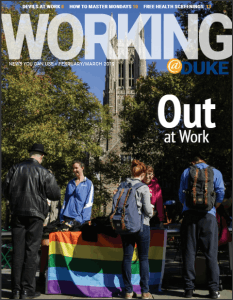How Duke University aces internal communications
By Sharon Aschaiek | Feb. 27, 2019
This Friday is National Employee Appreciation Day in the U.S., which makes it a good time to consider how well you conduct internal communications at your higher education institution.
There’s a lot to be learned from how Duke University in North Carolina, U.S., communicates with its almost 40,000 faculty and staff across the university and health system. Its bi-monthly print magazine for employees, Working@Duke, is an excellent example of institutional journalism. Established in 2006, it features well-researched, well-written, informative and engaging stories that are relevant and useful to employees as well as other community members at Duke. The magazine, which is mailed home or delivered through campus mail, is complemented by a digital section on the university news site Duke Today—also named Working@Duke, it is updated daily with new stories, most of which do not appear in print.

“We try to include stories that people can connect with in a real way. We take photos, do research and collect data to tell stories about our organization and people that reflect our mission and values,” says Leanora Minai, executive director of communications at Duke’s HR-based Office of Communication Services and editor of Working@Duke (print and digital).
Journalistic approach
Minai has been a communicator at Duke since 2004, but before that, she worked for 14 years as a newspaper reporter, so she brings a strong journalistic sensibility to Working@Duke. Together with two writers and a graphic designer, Minai and the team develop stories on a wide range of topics, including campus safety, employee benefits and programs, building renovations, campus events, and noteworthy activities of faculty and staff.
The February/March 2019 edition includes articles on topics such as the LGBTQ-inclusive climate in the Duke workforce, a Duke policing program that helps the homeless, and how employees can make the best use of their pharmacy benefit.

A major emphasis is placed on including news you can use—stories that provide practical strategies and helpful hints to address problems, be more productive and live a better life. As examples, the current print edition includes an article called “How to Master Mondays,” while the web section recently ran stories such as “The Dos and Don’ts of To-Do Lists” and “How to Bounce Back after a Mistake”.
“People love how-tos, content that is relevant and helpful,” Minai says. “What also works is using people to illustrate issues or programs, because that’s what resonates—people see themselves in other people,” she says.

One of the advantages of producing a university publication is having easy access to many subject matter experts. Minai and her team regularly turn to staff and faculty members across Duke’s 10 colleges or schools and 11 institutes or centres for information and insights for their articles.
Measuring effectiveness
So how does this sophisticated effort to inform and engage faculty and staff affect workplace morale and employee loyalty? Does all of this communication help Duke employees feel valued?
This is certainly a goal for Minai, one she tries to achieve and measure in different ways. First, she says, the content is designed to meet the expectations and interests of employees, which are gauged through twice-per-year employee surveys that ask about content preferences. The quality of the content is also driven by the adherence to a journalistic style, and by keeping a pulse on campus affairs and employee interests. The web analytics of articles are tracked weekly, and the insights help shape editorial plans.
Making this content easily available is key to helping employees feel connected to Duke. The information on the Working@Duke web section is shared in a weekly email blast, which has an average open rate of about 40%, which is much higher than the average rate of 20%. Articles are also posted regularly on Working@Duke’s social media channels.
A clue that their efforts are working is the high level of engagement with some editorial initiatives. For example, each summer, they invite employees to share photos of themselves on social media enjoying the season and to tag them with #DukeTimeOff. Last summer, the initiative generated about 700 photos. Another sign of success is that the Working@Duke print magazine has received 12 awards from the Council for Advancement and Support of Education for print internal audience publications and internal audience staff writing.
Duke has been named as a best place to work by several publications and organizations. There’s no doubt that high-quality internal communication can help drive employees’ workplace satisfaction. Minai continues to believe in the power of using meaningful, relevant storytelling about Duke and its people to connect with employees.
Says Minai: “Our hope is that by focusing on the people at Duke, and how, through their work, Duke is making a difference locally and in the world, that we’re helping to inspire and engage our employees.”
